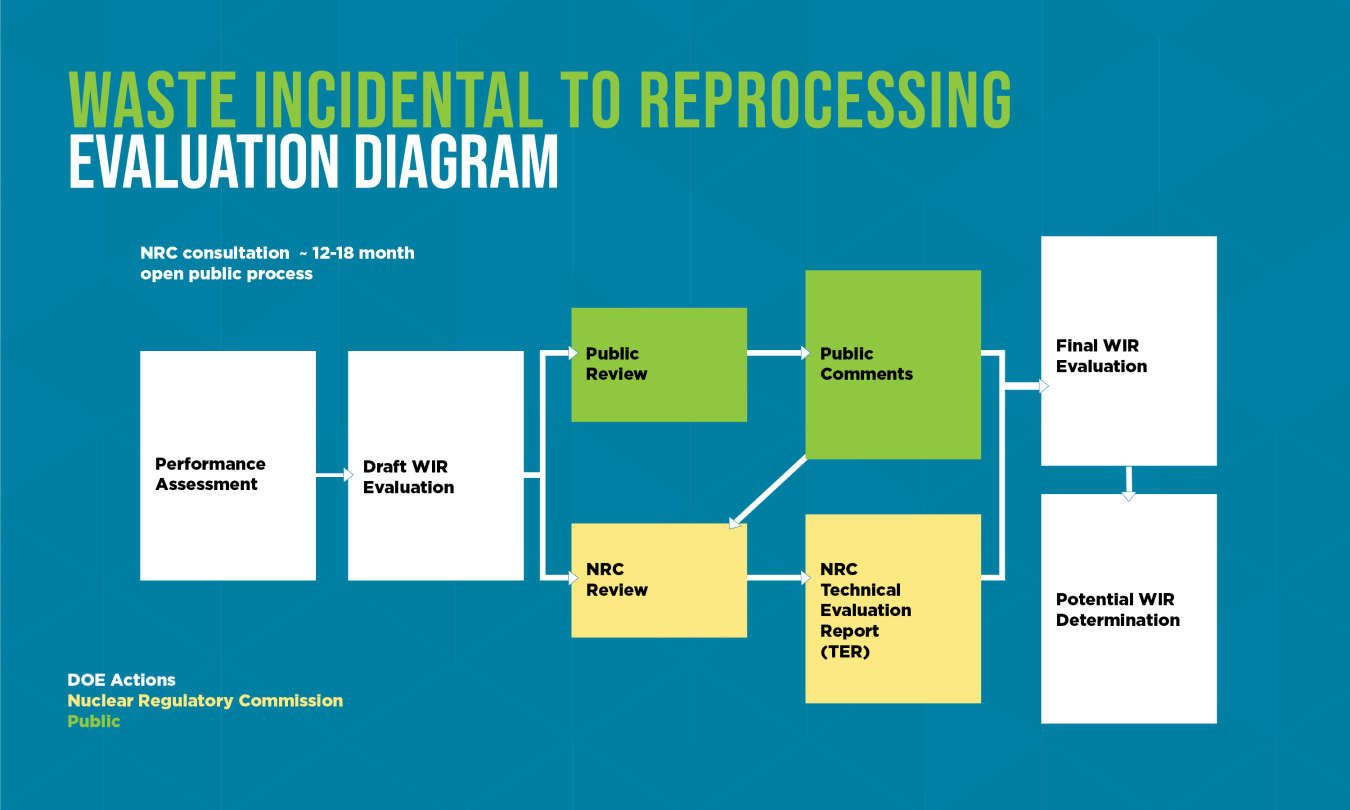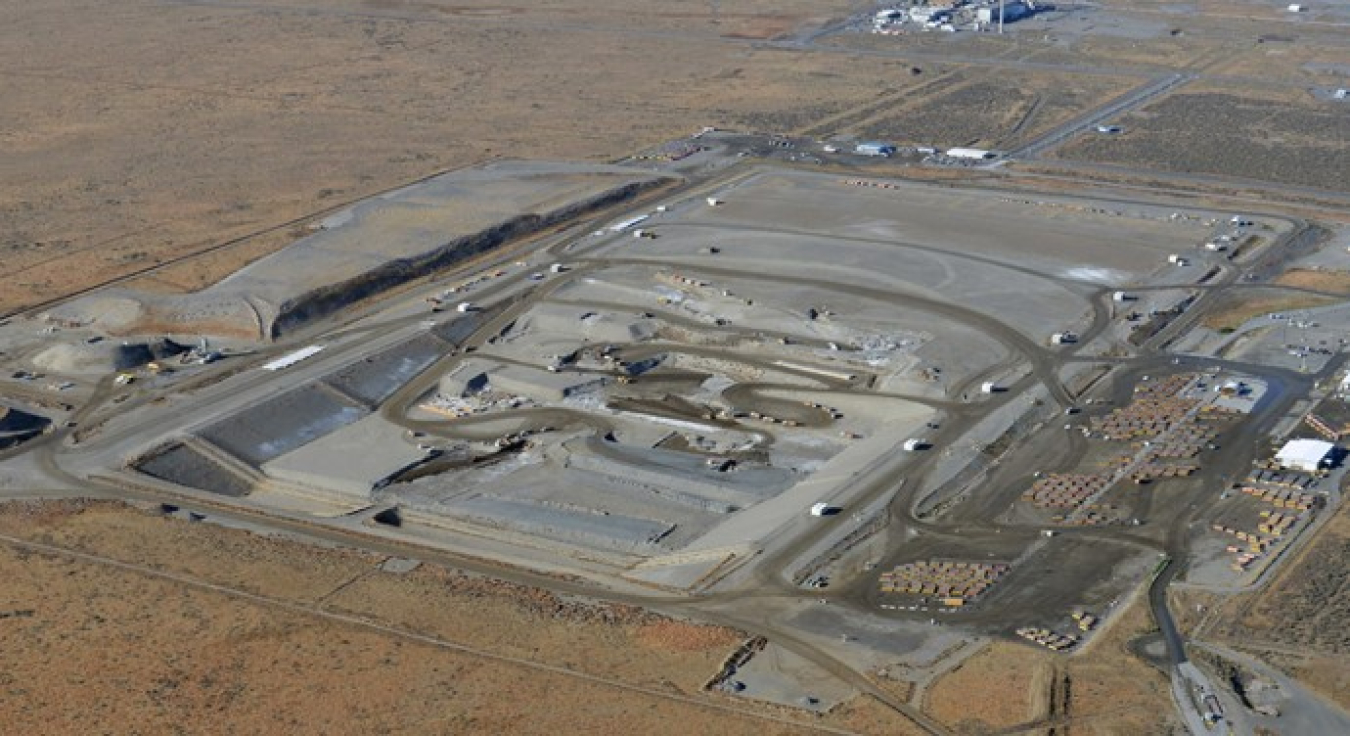
Liquid waste from reprocessing spent nuclear fuel is managed as high-level radioactive waste (HLW) and stored in tanks at the Savannah River Site, the Idaho National Laboratory, and the Hanford Site. As part of DOE’s Radioactive Waste Management program, certain reprocessing waste may be classified as non-HLW if the waste meets specific criteria. Reprocessing waste is waste generated from processes necessary to separate fissile elements and/or transuranic elements from other materials contained in spent nuclear fuel for the purposes of recovering desired materials. Wastes produced upstream or downstream from these separations processes are not HLW because they do not result from reprocessing. In general, upstream and downstream wastes do not contain the high levels of radioactivity that merit HLW management.
Under DOE Manual 435.1-1, DOE may determine that certain waste is non-HLW through application of the two waste incidental to reprocessing (WIR) processes--Citation or Evaluation. Reprocessing waste that is determined to be non-HLW is managed per the DOE requirements for low-level waste (LLW) in Chapter IV of the Manual (DOE M 435.1-1 also includes a process for determining through the WIR process that some waste may be managed as transuranic waste). Determinations are supported by radiological risk analyses, called Performance Assessments.
DOE may also determine that certain reprocessing waste is non-HLW by application of DOE’s HLW interpretation, if the waste meets the criteria in Chapter II of the Manual. Waste meeting the criteria may be classified, as LLW, and disposed based on its radiological characteristics, regardless of origin or previous categorization.
Additionally, under Section 3116 of the National Defense Authorization Act for Fiscal Year 2005 (NDAA), the Secretary of Energy may determine, in consultation with the NRC, that certain reprocessing waste in South Carolina or Idaho is LLW, and managed as such, where the criteria in Section 3116 are met. Section 3116 are similar in process to Evaluation process WIR determinations.
For disposal facilities, a waste acceptance criteria (WAC) is developed based on Performance Assessments. Performance Assessments are radiological risk analysis to determine potential public doses over long times frames from the radioactive waste to provide reasonable assurance that performance objectives for safety of the public can be met. Any radioactive waste DOE dispositions must meet the disposal facility’s WAC or the low-level waste performance objectives in Chapter IV of DOE M 435.1-1.

WIR by Citation Process
Under DOE Manual 435.1-1, Chapter II.B.(1), DOE field offices may determine through a WIR by citation process that certain reprocessing waste is non-HLW. WIR by citation includes reprocessing plant wastes that meet the description included in the Notice of Proposed Rulemaking (34 FR 8712) for proposed Appendix D, 10 CFR Part 50, Paragraphs 6 and 7. These radioactive wastes include, but are not limited to, items such as clothing, tools, and equipment.
The field offices managing reprocessing waste have internal contractors implementing procedures approved by the field office manager, or designated authority, for waste determined to be WIR by citation. These procedures evolved after dialogue among the HLW sites and DOE EM Headquarters staff.
WIR by Evaluation Process
Under DOE Manual 435.1-1, Chapter II.B.(2), DOE field offices may determine that certain reprocessing waste is non-HLW using the WIR Evaluation process, where an evaluation shows that the waste meets certain criteria. DOE publishes a draft WIR evaluation, including supporting references such as a Performance Assessment, and consults with the NRC. Although not required by DOE Manual 435-1-1, DOE and NRC have agreed to an open public consultation process where documentation between the agencies, meetings and clarification calls discussing technical topics are open to the public to review or observe. DOE will also request public comments on the draft evaluation. DOE will consider public comments and NRC’s consultative advice to finalize the evaluation before making a determination the waste is non-HLW.
Generally, DOE must show that the waste can be safely disposed by removing as much radioactivity as feasible, meeting NRC low-level waste classification limits for shallow-land disposal, and complying with dose limits established by NRC for LLW.
The WIR Evaluation criteria in DOE M 435.1 include reprocessing wastes that will be managed as low-level waste and meet the following criteria:
- Have been processed, or will be processed, to remove key radionuclides to the maximum extent that is technically and economically practical; and
- Will be managed to meet safety requirements comparable to the performance objectives set out in 10 CFR Part 61, Subpart C, Performance Objectives; and
- Are to be managed, pursuant to DOE’s authority under the Atomic Energy Act of 1954, as amended, and in accordance with the provisions of Chapter IV of DOE M 435.1-1, provided the waste will be incorporated in a solid physical form at a concentration that does not exceed the applicable concentration limits for Class C low-level waste as set out in 10 CFR 61.55, Waste Classification; or will meet alternative requirements for waste classification and characterization as DOE may authorize.
DOE Manual 435.1-1 WIR Evaluation determinations are approved by the Field Element (Site) Manager after the consultation processes noted above are taken.
Read more about the NRC Consultation and Public Input Process
High-Level Radioactive Waste Interpretation
On January 19, 2021, DOE issued a Federal Register notice incorporating its interpretation of the statutory term high-level radioactive waste (HLW) in DOE Manual 435.1-1, Chapter II.C, which states reprocessing waste is non-HLW if the waste:
(a) does not exceed concentration limits for Class C low-level radioactive waste as set out in section 61.55 of title 10, Code of Federal Regulations, and meets the performance objectives of a disposal facility; or
(b) does not require disposal in a deep geologic repository and meets the performance objectives of a disposal facility as demonstrated through a performance assessment conducted in accordance with applicable requirements.
Read more about High-Level Radioactive Waste Interpretation
Section 3116 Determination
In October 2004, Congress enacted the Section 3116 of the National Defense Authorization Act for Fiscal Year 2005 (NDAA). Section 3116 provides that the Secretary of Energy, in consultation with the NRC, may determine that certain waste is not HLW if the waste meet certain criteria. These determinations are similar in nature to WIR determinations in that it applies to wastes for which radioactivity has been removed and complies with concentration and dose limits established by NRC for LLW. The determination is supported by a basis document (as opposed to a WIR evaluation under the WIR Evaluation process). Currently, Section 3116 only applies to waste that are disposed in Idaho and South Carolina (“covered states”). Section 3116 also requires that NRC, in coordination with the covered state, monitor DOE waste disposal actions authorized by a Section 3116 determination to assess DOE’s compliance with the performance objectives set forth in Subpart C of 10 CFR Part 61, Licensing Requirements for Land Disposal of Radioactive Waste.
The Section 3116 criteria are that the reprocessing waste:
- Does not require permanent isolation in a deep geologic repository for spent fuel or high-level radioactive waste;
- Has had highly radioactive radionuclides removed to the maximum extent practical; and
- (A) Does not exceed concentration limits for Class C low-level waste as set out in section 61.55 of title 10, Code of Federal Regulations, and will be disposed of—
- In compliance with the performance objectives set out in subpart C of part 61 of title 10, Code of Federal Regulations; and
- Pursuant to a State-approved closure plan or State-issued permit, authority for the approval or issuance of which is conferred on the State outside of this section; or
- (B)Exceeds concentration limits for Class C low-level waste as set out in section 61.55 of title 10, Code of Federal Regulations, but will be disposed of—
- In compliance with the performance objectives set out in subpart C of part 61 of title 10, Code of Federal Regulations;
- Pursuant to a State-approved closure plan or State-issued permit, authority for the approval or issuance of which is conferred on the State outside of this section; and
- Pursuant to plans developed by the Secretary in consultation with the Commission.
Read more about the NRC Consultation and Public Input Process
WIR Evaluations Currently Underway
Completed Determinations

